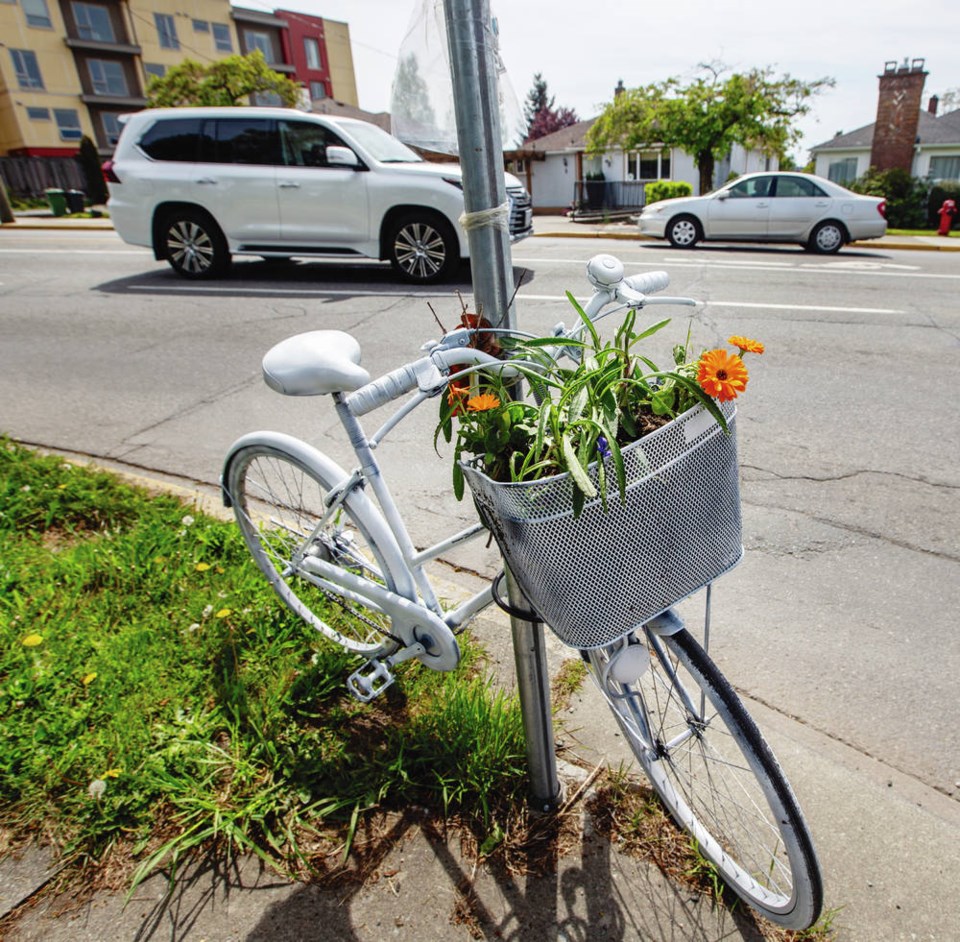Some roadside memorials bring you down. They drag you into somebody else’s grief, an unwanted reminder that a tragic death happened right here.
Often the impromptu shrines grow grimmer as time goes by. The hand-lettered signs fade, the shrink wrap peels off the photos and the desiccated flowers blow away, leaving the impression that the person being remembered has, in fact, been forgotten.
But that’s not what happened on Gorge Road by Harriet Street, the scene of a collision in which a cyclist was fatally injured on Nov. 6.
The cyclist’s identity was never revealed. We weren’t told how old she was, or anything about her at all, really, though it was reported that her family didn’t live in Canada. Authorities seldom divulge the names of victims anymore, reasoning that to do so would be a breach of their privacy. Perhaps, but it also means some people die in anonymity, making their passing easier to forget.
Someone remembered this woman, though. Not long after she died, bouquets began to appear, taped to a traffic sign at the intersection.
Neighbour Ian Ferguson says this happened regularly, a new bunch of flowers replacing the old ones before the latter could wilt. “They were never allowed to get droopy.”
Then, this week, something new: A woman’s bicycle, painted white, with orange flowers growing from the earth-filled basket, was locked to the post. It looks … nice.
“Oh, that’s so pretty,” said one woman, rounding the corner and seeing the bike for the first time. Did she know about the fatal crash? No, but seeing the bicycle brightened her day.
Ferguson likes it, too. “It’s like a piece of public art,” he says. “To me, it’s the antithesis of all the graffiti that’s popping up.”
The piece is a distinctive addition to the streetscape even without knowing why the artist chose a bicycle, he says — though the effect is greater when put in context. “If you know what happened, it’s quite touching.”
It’s reassuring, Ferguson says, to know that somebody cared about this unnamed woman. Wouldn’t we all like it to be acknowledged that we existed and mattered? “You want to leave some marker behind that says ‘I was here.’ ”
There’s not always consensus on where those markers should be, though. There’s an argument that memorials should be erected where we lived our best, not where we died.
There’s no consistent approach to roadside shrines by officialdom. Some jurisdictions allow them, some place time limits on how long they may stand, while others ban them outright. The bans are often done in the name of safety, though sometimes that’s just code for “we don’t want to see them.”
Here’s how a Nanaimo News Bulletin reader put it in March: “I empathize with you and am not insensitive to your grief. However, please think of others who didn’t know your loved one. I am constantly reminded of sadness and death as I go about my day driving by these memorials. This is what cemeteries are for, so you can go and remember those you’ve lost on your terms.”
Ours is not a culture that is comfortable with public expressions of grief — though it’s more comfortable than it was 30 years ago, when roadside memorials were rarely seen. What changed? In part, according to Arthur Jipson, a University of Dayton, Ohio, professor who researched the phenomenon, it was simply a matter of one memorial leading to another, their proliferation sending the message that it’s socially acceptable to erect them. Some mourners use them to channel grief into public service — a reminder not to drink and drive, or a plea to improve road safety, or a call for justice.
In Duncan, where a bylaw requires informal memorials to be removed from city land after 15 months, there was awkwardness over one erected at the downtown park where married couple Nellie Williams and Fran Shurie were fatally attacked on Christmas Eve 2019. A month ago, Williams’s mother told CHEK News that she feared that without the memorial at the crime scene, people would forget about her daughter and son-in-law, and the unsolved case would grow colder. Still, she moved the memorial to the victims’ gravesite.
For government, it becomes a delicate dance, as shown by the approach of B.C.’s Transportation Ministry to roadside memorials: “Out of respect for grieving family and friends, the ministry allows placement of roadside memorials within provincial highway rights-of-way at, or near, the accident site. If the ministry determines it is necessary to remove items like these for safety, construction or maintenance purposes, we will attempt to contact the individuals who placed them and facilitate their relocation or removal.”



